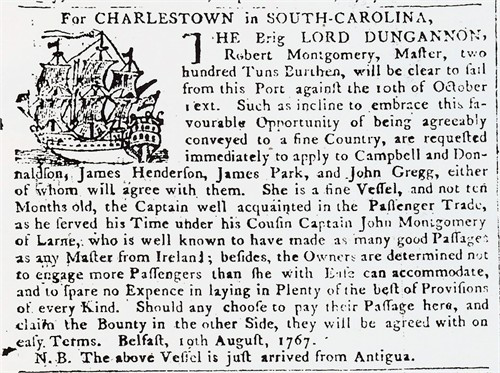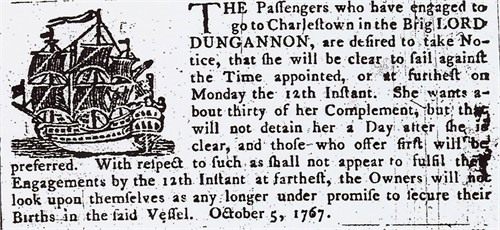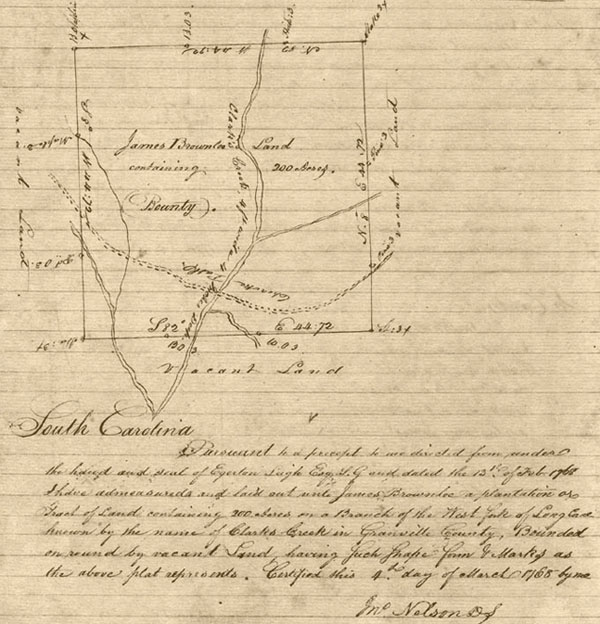**4th-Great maternal Grandparents of Eula Claudine Reed
James Brownlee**:
Parents: John Brownlee & Eleanor Brownlow
Born: About 1735 (Ireland)
Died: June 12, 1798 (Abbeville County, South Carolina)
Buried: Unknown (unknown)
Jean Webb** (first spouse):
Parents: Unknown & Unknown
Born: About 1736 (Ireland)
Married: About 1752 (Ireland)
Died: About 1768 (Ireland)
Buried: Unknown (unknown)
Sarah Trimble (second spouse):
Parents: Walter Trimble ? & Rosanna ?
Born: Unknown (Virginia ?)
Married: About 1770 (South Carolina)
Died: Before July 20, 1789 (Abbeville County, South Carolina)
Buried: Unknown (unknown)
Children (first spouse):
- Jane Brownlee (Born: about 1749);
- George Harvey Brownlee** (Born: about 1756);
- John Brownlee (Born: about 1759).
Children (second spouse):
- William Brownlee (Born: about 1770);
- Elizabeth Brownlee (Born: about 1772);
- James Brownlee (Born: about 1775).
Genealogical Sketch:
Prior to 1767, James Brownlee is believed to have married Jean Webb and have been living in the County of Armagh (possibly in the town of Portsdown). From 1608-1641, Armagh County had been part of the Ulster Plantation scheme to subdue the Irish Catholics with the resettlement of protestant tenet famers from the Scotland lowlands.
At the age of 32, James Brownlee and his 40 year-old brother John Brownlee with their families departed form the port in Belfast (Ireland) aboard “The Lord Dungannon“.[1] According to the following notices, “The Lord Dungannon” had arrived in August from Antigua (likely transporting rum) and was set to sail for “Charlestown” (Charleston, South Carolina) on October 10, 1767. As of the October 5, 1767 notice, the owners of “The Lord Dungannon” were still hoping to add an additional 30 passengers and had delayed the departure to Monday October 12, 1767.

Notice was posted in the Belfast Newsletter.

Notice was posted in the Belfast Newsletter.
- A third brother, William Brownlee also received his land bounty in 1768. Although William Brownlee was not listed on any of passenger lists, a William Brownlow arrived with his family from Ireland in Charleston aboard the Earl of Donegal on December 20, 1767. The Earl of Donegal had sailed from Belfast on October 2, 1767. The passenger list of 294 Irish protestants included William Brownlow (40), his wife Jane Brownlow (34), son John Brownlow (5), and son James Brownlow. Also on the list was James Brownlow (30) with Mary Caldwell (30) and her son James Caldwell.[2]
James Brownlee, his brother John Brownlee, and their families were taking advantage of the “Bounty System” that was set to expire in South Carolina on the last day of the General Assembly in July 1768. To encourage immigration, the South Carolina Assembly had offered “four pounds sterling” to “every free poor protestant” above the age of twelve (“two pounds sterling” for ages 2-12) “to defray the expense of the passage” along with an additional “twenty shillings” for those above the age of two “to enable them to purchase tools and provisions“.[3]
After a 112 day voyage “The Lord Dungannon” arrived in Charleston (South Carolina) with 154 passengers on February 1, 1768. The 32 year-old James Brownlee, his 18 year-old daughter Jane Brownlee, his 11 year-old son George Brownlee, and his 8 year-old son John Brownlee were listed as passengers. It is believed his wife Jean Brownlee died before voyage, but it is possible she died while at sea. Among the other passengers was John Brownlee (the 40 year-old brother of James Brownlee), his 36 year old wife Alice Brownlee, his 19 year-old son Joseph Brownlee, and his 15 year-old daughters Alice and Ann Brownlee.[4] Most of the passengers were believed to have been from Belfast and Larne regions of Northern Ireland.
- The British encouraged settlement by “poor protestants” in the South Carolina frontier (upcountry) to provide a buffer between the Native Americans and the wealthy plantations in the South Carolina low-country.
On March 4, 1768, a Plat was recorded for James Brownlee for 200 acres “on a branch of the West Fork of Long Cane known by the name of Clarks Creek” in Granville County, South Carolina. The land was bounded by vacant land (Clarks Creek would later be known as Chickasaw Creek) and shared a corner with the plat of James Webb (1716-1794). Nearby were the plats of future in-laws Andrew Cowan and Samuel Lindsay.

- On December 4, 1765, the South Carolina Council granted the petition of 49 year-old James Webb (a “poor protestant” from Belfast Ireland) for 350 acres in Boonesborough Township under the Bounty Act.[5] Originally surveyed by Patrick Calhoun at a key point on the Cherokee trail for settlement of Irish protestants in 1762, the area was known as DeWitt’s Corner by 1777 and would form the small rural towns of Donalds and Due West.
With his new land and provisions, James Brownlee established his self-sufficient homestead for his family on the waters of “Chickasaw Creek“. Located near the “Cherokee Path“, this backcountry settlement of predominately Ulster-Scots Prebysterians was planned to provide a buffer between the Cherokee and the large established English plantations of the “low country” of South Carolina. Without any courts until 1769, the new settlement relied on bands of neighbors to resolve disputes which led to deep divisions within the rural community.
By 1770, James Brownlee had met and married his second wife, Sarah Trimble. Not much is known about Sarah Trimble. It is likely she is related to Walter Trimble, John Trimble, or James Trimble (see Tracing Millers Migration from Pennsylvania to South Carolina). Plats were recorded nearby for both Walter Trimble (Long Cane Creek) and John Trimble (Rocky Creek) on the same date in 1766; and a plat for James Trimble (waters of Long Canes) was recorded in 1768. Both John Trimble and James Trimble receiving plats of 100 acres (indicating they were single with no children), indicates Walter Trimble with 200 acres likely Sarah’s father.
- Walter Trimble and his wife Rosa are believed to have immigrated from Ireland to Virginia in the 1730s prior to relocating to South Carolina.[6] In 1791, Walter Trimble died in Washington County, Tennessee.
- Both John Trimble and James Trimble petitioned the South Carolina Assemble and received pay for serving as privates in the patriot militia in 1780.
Following the American Revolution, James Brownlee increased the size of his plantation. On August 7, 1784, a plat was recorded for James Brownlee for 66 acres on “Chichisaw Creek” in District Ninety-Six of South Carolina.[7] On February 20, 1785, a plat was recorded for James Brownlee for 150 acres “on Branch of Hogskin Creek” in District Ninety-Six of South Carolina.[8] On March 16, 1793, a plat was recorded for James Brownlee for 160 acres “on Branches of Chickesaw Creek” in District Ninety-Six of South Carolina.[9]
According to the first Federal Census in 1790, the 16+ year-old James Brownlee was living in Abbeville County, South Carolina. James Brownlee owned three slaves.
- Living in the preceding household was the son of James Brownlee, George Brownlee (16 and over). George Brownlee was living with another free white male (16 and over), a free white male (under 16), and four free white females. George Brownlee owned one slave;
- Living two households away was the son of James Webb, Andrew Webb (16 and over). Andrew webb was living with two free males (under 16) and five free white females. James Webb lived a few households away;
- Living close by was the brother of James Brownlee, John Brownlee (16 and over). John Brownlee was living with his wife and owned two slaves;
- Living next to James Brownlee’s brother was the son of James Brownlee, William Brownlee. William Brownlee (16 and over) was living with his wife and son (under 16).
On June 12, 1798, the will of James Brownlee was proven in Abbelville County, South Carolina. The will was witnessed by his son Joseph Brownlee, Andrew Webb, and Alexander Elgin (see transcription).[10]
“In the name of God, amen, the 20th day of July 1789. I, James Brownlee, of the State of South Carolina, in Ninety-Six District, planter, being very sick in body but of good and perfect memory, thanks be to the Almighty God for it and calling to remembrance the uncertainty of this transitory life and that all flesh must die when it shall please God to call them and declare this my Last Will and Testament. In manner and form following, first being penitent and sorry for all of my sins most humbly desiring forgiveness of the same, I commend my soul unto the Almighty God, my Savior and Redeemer, in whom and by whom, merits trust and believe to be saved. My body I commit to the Earth to be decently buried at the discretion of my Executors, hereafter named and for the settling of my temporal state. And such good chattels and debts as it hath pleased God to bestow upon me, I do order and give dispose the same in manner and form following.
And first, I leave to my son, William, one hundred acres of land, to my daughter, Elizabeth, one hundred acres of land joining William and to my son, William two cows and a steer, the remainder of the cattle to be divided between Betty and James. I give the Negro, Fridy, to my son, James, and to my son, James, the chest with the lock and to my son, James, all the horses and mares and he to give Betty one horse, the pueter to be divided between Betty and James and to my son, George, I leave half a crown. I likewise make and ordain Joseph Brownlee and John Ricky to be Executors of my Last Will and Testament and I do hereby utterly disallow, revoke and all and other form of Wills and confirming this and no other to be my Last Will and Testament in Witness, whereof, I have set my hand this 21 day of July 1789.“
- James Brownlee does not mention his son John Brownlee or daughter Jane Robertson in his will. Possibly as both lived in Charleston.
Gravestones:
The grave sites of James Brownlee and his second wife Sarah Brownlee are not known. His son George Brownlee and many on his descendants are buried in the historic Greenville Presbyterian Church Cemetery in Abbeville County, South Carolina. Interestingly, James Brownlee’s neighbor James Webb (possibly related to first wife Jean Webb) and his wife Elizabeth (Maxwell) Webb are also buried in the the Greenville Presbyterian Church Cemetery.
[1] Compilation of Original Lists of Protestant Immigrants to South Carolina (1763-1773) compiled by Janie Revil, Pages 104-107.
[2] Compilation of Original Lists of Protestant Immigrants to South Carolina (1763-1773) compiled by Janie Revil, Pages 87-93.
[3] South Carolina Carolina Gazette, 1761 (missing date of publication).
[4] Compilation of Original Lists of Protestant Immigrants to South Carolina (1763-1773) compiled by Janie Revil, Pages 104-107; South Carolina Immigrants (1760 to 1770) by Jack Moreland Jones and Mary Bondurant Warren (need page number).
[5] Compilation of Original Lists of Protestant Immigrants to South Carolina (1763-1773) compiled by Janie Revil, Page 46.
[6] Trimble Families of America by John Farley Trimble, Page 220; The Trimble Trail by Wanda June Trimble Hutcheson, Page 9.
[7] South Carolina Department of Archives, Series S213190, Vol. 3, Page 20, Item 1.
[8] South Carolina Department of Archives, Series S213190, Vol. 1, Page 104.
[9] South Carolina Department of Archives, Series S213190, Vol. 29, Page 38, Item 1.
[10] Abbeville County (South Carolina) Will Book I, Page 216 (Box 105, Pkg. 2676).
Hey, Im a desendent of these Brownlees, me mother was a Brownlee and I’d like to dialogue with you more on subject of Brownlee family trees and arrival in Charleston, SC. VR, Grandson of Christopher Columbus Brownlee, Orval Windham
LikeLike
Thanks for reaching out to us! I will send you an email address.
LikeLike
My Grandfather is Christopher Columbus Brownlee, son of John Wesley Brownlee, son of William Redman Brownlee, son of James Brownlee, son of John Wesley Brownlee; John Wesley Brownlee, last mentioned did not come to the new world, he was born and passed away in Wales, UK.
LikeLike
Interesting, I saw that William Redman Brownlee was reported to have been born about 1792 in Union County (South Carolina); and his father John Wesley Brownlee was reported to have been born about 1770 in Wales. If this is correct, John Wesley Brownlee arrived in South Carolina sometime after our branch. Do you know if there has been any Y-DNA testing to determine if our branches are related?
BTW…If you did not receive our email, I will send it again.
LikeLike
To the question did i get the email? Yes i have it, and thank you.
Some members sailed on Lord Dungannon with Captain Montgomery in command, from Belfast Oct-Nov 1767 arriving Charleston, Feb 1768. Up to now, I am persuaded that James Brownlee was on this ship… situation is however, fuzzy without a copy of the ships passenger list. MS Ulmer; MS Tremble I’ve seen infos of their marriages but no court documents.
NO i have no knowledge of Y-DNA tests…
VR, Orval Windham
LikeLike
Fortunately for us, our James Brownlee and his family were among the passengers reported by Lord Dungannon’s Captain Montgomery to the South Carolina Council. I have updated our post to include a better citation of this. I also included the citation for a two year-old James Brownlow (likely Brownlee) who was listed as part of 40 year-old William Brownlow’s family on the passenger list provided for the Earl of Denegal that arrived around the same timeframe. While it does appear this William Brownlow may be related to our James Brownlee, I do not believe this has been proven indicating the need for Y-DNA testing. I did a quick check of the Brownlow/Brownlee Y-DNA surname project, but it was unclear if anyone from these lines has participated without contacting an administrator of the project. As a male Brownlee descendant, if you are interested you could contact the administrators to learn more.
LikeLike